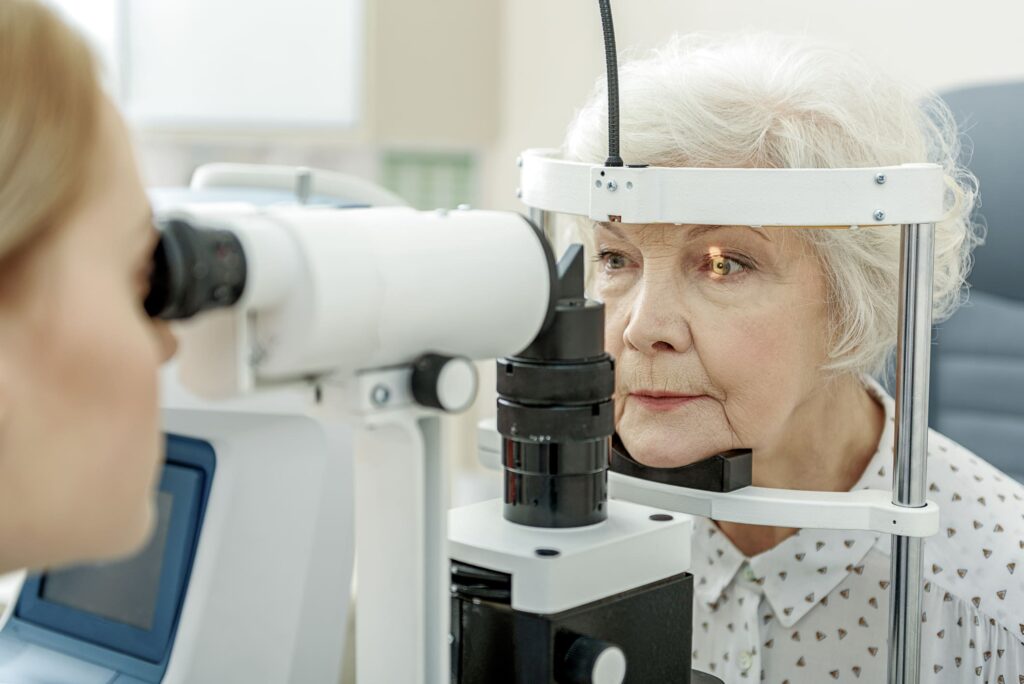While it’s highly effective on its own, MacuMira Vision Therapy is also the perfect complement to other dry AMD treatment components, such as nutraceuticals.
Understanding AMD and its treatments
Age-related macular degeneration (AMD) is an eye disease that generally develops due to aging, genetics and/or outside factors like smoking. It is one of the leading causes of blindness in adults aged 55 years and older.[1] There are two types of AMD, dry AMD and wet AMD (a more severe form). Dry AMD can progress into wet AMD in about 10-20 per cent of the AMD population.
Traditionally, therapies for patients with dry AMD — the most common form of AMD — have included treatments such as nutraceuticals-based therapies, complement inhibition, gene therapy, visual cycle modulators, neuroprotection, anti-inflammatory therapies, photobiomodulation and prostheses — most of which are painful and invasive, such as eye surgeries or eye injections.[2]

The role of nutraceuticals in AMD care
People with dry AMD may also benefit from taking nutraceuticals, a specific mix of vitamins and minerals, which may include vitamin C, vitamin E, lutein, zeaxanthin, zinc and copper. These may lower the risk of getting late-stage dry AMD called geographical atrophy, or wet AMD.[3] Other vision supplements are also available that are clinically proven to help strengthen all three macular carotenoids, which are essential for preserving macular health, protecting macular pigment and supporting clear vision throughout a person’s life.[4],[5]

MacuMira Vision Therapy: A non-invasive AMD treatment
These vitamin and mineral supplements fall into the class of nutraceuticals, a term derived from “nutrition” and “pharmaceuticals.”[6] Nutraceuticals are products that are isolated from herbal products or dietary supplements (nutrients) that are also used as medicine.[7]
While many of the traditional therapies offered to AMD patients cause pain and discomfort — namely, the surgeries and regular eye injections — taking supplements or nutraceuticals offers patients a more approachable, easy and convenient way to help them manage their disease.
MacuMira Vision Therapy offers a treatment option for dry AMD patients that is far more comfortable, and clinically effective, than many of the existing traditional therapies. MacuMira Vision Therapy uses non-invasive eyelid surface neurostimulation to deliver a patented microcurrent through a patient’s closed eyes. This is a quick and easy process that improves visual acuity by an average of 8.8 letters on ETDRS chart.
Patients receive the painless treatment while seated comfortably, and most sessions last an average of 30 minutes.
A breakthrough in dry AMD treatment
MacuMira Vision Therapy’s innovative technology has demonstrated meaningful results, as shown in a clinical study examining its impact on patients and demonstrating its long-term effects. “It’s quite exciting to be able to now offer something other than just nutraceuticals,” says Dr. Wes McCann, an optometrist at Central Optometry (an AMD Centre of Excellence) in London, Ont., and CEO of Doctors Vision Group. “We finally have a treatment option for patients with dry AMD. It’s going to make a world of difference for patients.”
Combining MacuMira Therapy with nutraceuticals for better results
MacuMira Vision Therapy is a perfect complement to other existing AMD therapies, such as taking nutraceuticals. The two therapies — MacuMira Vision Therapy and supplementation — mutually complement each other, supercharging the quality of outcomes for patients. While MacuMira Vision Therapy is currently the only clinically-approved treatment in Canada for early, dry AMD, doctors also recommend that patients make lifestyle changes such as improving their diet, quitting smoking and exercising regularly in order to potentially slow the advance of dry AMD. In all cases of AMD, especially in the early stages, nutraceuticals are recommended as they may also help to slow the progression of the disease.
When it comes to vision, patients will take every measure possible to preserve and improve their visual acuity — and taking advantage of a multitude of therapy options is an ideal strategy for dry AMD patients. Improve your vision and your quality of life by adding the powerful effects of MacuMira Vision Therapy to your existing dry AMD treatment plan.
Don’t let dry AMD limit your life. With MacuMira Vision Therapy’s non-invasive, powerful treatment combined with other therapies like nutraceuticals, you can regain control over your eye health. Speak with your eye care professional today and discover how MacuMira Vision Therapy can be a vital part of your personalized treatment strategy.
Your vision is invaluable—schedule a consultation today and see how MacuMira Vision Therapy can make a difference!
Disclaimer: Always speak to your primary health care provider and/or eye care provider before making any changes to your lifestyle, activities or diet.
References
[1] https://centraloptometry.com/service/amd-centre-of-excellence/
[2] https://www.ncbi.nlm.nih.gov/pmc/articles/PMC8720345/
[3] https://www.aao.org/eye-health/diseases/vitamins-amd
[4] https://centraloptometry.com/service/amd-centre-of-excellence/
[5] https://cdn.macuhealth.com/wp-content/uploads/2015/09/Sustained-supplementation.pdf
[6] https://www.ncbi.nlm.nih.gov/pmc/articles/PMC4336979/
[7] Ibid.




